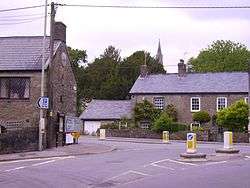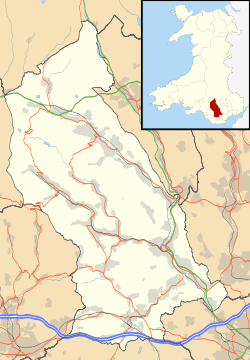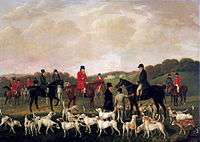Llanharan
| Llanharan | |
| Welsh: Llanharan | |
 Llanharan Square with the Church of St Julius and Aaron in the background |
|
 Llanharan |
|
| Population | 3,465 (2011)[1] |
|---|---|
| OS grid reference | ST012818 |
| Principal area | Rhondda Cynon Taf |
| Ceremonial county | Mid Glamorgan |
| Country | Wales |
| Sovereign state | United Kingdom |
| Post town | Pontyclun |
| Postcode district | CF72 |
| Dialling code | 01443 |
| Police | South Wales |
| Fire | South Wales |
| Ambulance | Welsh |
| EU Parliament | Wales |
| UK Parliament | Ogmore |
| Welsh Assembly | Ogmore |
|
|
Coordinates: 51°32′N 3°26′W / 51.53°N 3.43°W
Llanharan (Welsh: Llanharan) is a village and community in the county borough of Rhondda Cynon Taf, Wales. As a community Llanharan takes in the neighbouring settlements of Bryncae, Brynna, Llanilid, Peterson-super-Montem and Ynysmaerdy. Llanharan thrived during the British industrial revolution, with several tin and coal mines in the location providing employment to the town's residents. With the decline of heavy industry in the South Wales Coalfield, Llanharan has been in economic decline, though its proximity to the M4 motorway offers its residents easy commutable access to most of South Wales.
The most recognisable features of Llanharan are its historic town square, Llanharan House and Church of St Julius and Aaron.
Landmarks and notable buildings
Llanharan House
On the outskirts of Llanharan, overlooking the village, sits Llanharan House. It was built in 1750 by Rees Powell and stayed with the Powell family until 1795 upon which it was purchased by Richard Hoare Jenkins. Hoare Jenkins was a High Sheriff of Glamorgan and he was involved in the suppression of the Merthyr Rising of 1831, and is recorded as stating he found the execution of Dic Penderyn as the most difficult of his civic duties. Around 1800 some major improvements were made to the house with the addition of a three-storey circular stair hall which includes a dramatic geometrical staircase.[2] Following the death of Hoare Jenkins in 1856 the house and the estate was passed to a Colonel John Blandy-Jenkins. Following his death in 1915 Colonel Blandy-Jenkins's wife kept the house until 1953.

Llanharan house has a strong historical connection with fox hunting. This Welsh pack was named The Llanharan and was established by Richard Hoare Jenkins in 1805, though the pack was renamed the Llangeinor during the period when Mr John Blandy Jenkins was the squire.[3] The Llangeinor is now based in Coity near Bridgend.
Llanharan House is a Grade II listed building.[4]
The Church of St Julius and Aaron
The local parish church is the Church of St Julius and Aaron whose interior was redesigned in its present form by neo-gothic architect John Prichard around 1856,[5] with work completed by 1859. The restoration work was financed by the Jenkins family of Llanharan House.[6]
Llanharan Town Square
Llanharan Town square consists of several historical stone buildings situated by the local river the Ewenny Fach. Llanharan town square is dominated by a public house called The High Corner which dates back to roughly 1700. Outside the High Corner is an original red telephone box.
Employment
Prior to the British Industrial Revolution, Llanharan was a small agricultural village, and this was reflected in the 1851 census where a population of 330 people living in 62 buildings was recorded. In 1850 the South Wales Railway had opened a station in Llanharan making it a strategic location for surrounding industries. Later employment came from the nearby iron mines in Llanharry and Pontyclun. Towards the end of the 19th century an additional 80 houses had been built and Llanharan had a population of over a thousand.
With the discovery of coal an attempt to sink two mine shafts began between 1870 and 1873, but the work was eventually abandoned as the pit was too wet and inclined.[7]
In the early 1880s, in a different location to the first sinking attempt, the first deep mine in Llanharan was opened, the Meiros Colliery. The Meiros was listed in 1888 as owned by the Llanharan Welsh Estate of Cardiff; employing 228 men.[8] The Meiros shaft was 200 yards deep and it mined the No. 3 seam (Rhondda). Meiros Collieries Ltd took over the colliery in 1913, and in 1915 the colliery underwent considerable modernisation. At its peak in 1923, the colliery was employing 622 men. The Meiros Colliery closed in the 1930s.
The Powell Duffryn Company restarted the sinking of the original steam coal seams abandoned in the early 1880s in 1922. This was named the Llanharan Colliery and consisted of two pits, Llanharan North and South pits which in 1945 employed a total of 855 and 775 men respectively. Output form the colliery was at its highest in the early and mid-1950s, producing over 234,000 tons of coal in 1952. From 1959 production began to fall sharply, and in 1962 Llanharan Colliery was closed down.[9]
From 1900 until the Powell Duffryn's Llanharn colliery closed in 1962, the area westward along the Bridgend Road became the commercial heart of a relatively flourishing mining village that survived even the depression years.
Since the 1970s the residents of Llanharan have become more reliant on commuting to work as local employment reduces. Local amenities have also closed over the years including Llanharan's cinema, railway station and library.
In 2015 a new source of work came with the building of a set for the filming of the medieval drama The Bastard Executioner.
Arts and Entertainment
In 1997 Llanharan rugby ground was used in the box office smash film Up 'n' Under is a 1998 film adaptation of the John Godber play of the same title.
Education
There are two Primary Schools presently serving the community of Llanharan, they are Dolau Primary School and Llanharan Primary School.
Transportation
Llanharan is served by many buses and also Llanharan railway station, which reopened in December 2007 after 43 years of closure. The main road running through Llanharan is the A473 Bridgend Road, linking Bridgend to its West and Talbot Green to its East.
Sports
Llanharan RFC
The village hosts a Rugby Football team, Llanharan Rugby Football Club, who play in the Welsh Rugby Union Championship Division. The club formed in 1891 and was awarded membership to the WRU in 1919. Llanharan RFC play in black shirts and shorts with three light blue horizontal hoops across the chest. Their nickname, the "Black and Blues", is taken from their colours. Their home ground is named The Dairyfield, and there is also another pitch available to the clubs disposal, The Welfare Ground.
South Wales Warriors
As of the 2009 season, The Dairy Field in Llanharan has been the home field of the South Wales Warriors American Football team.[10] The Warriors play in the Western Conference of Division Two of the British American Football Association National Leagues, the primary American Football league of the United Kingdom.
Welsh Springer Spaniel
It is thought that the breed of dog, the Welsh Springer Spaniel, either found its origins or was historically successfully bred in Llanharan. Some breeders speak of the “Llanharan Spot”, if one describes the red point in the middle on the head of the Welsh. The Llanharan Spaniel makes up part of the Llanharan RFC club badge.
Notes
- ↑ "Population Density, 2011". Office for National Statistics. neighbourhood.statistics.gov.uk. Retrieved 3 January 2014.
- ↑ Glamorgan County History, Volume VI, Glamorgan Society 1780-1980; Prys Morgan, University of Wales Press, Cardiff (1988)pg. 402
- ↑ Foxhounds of Great Britain and Ireland and their Masters and Huntsmen, written by Sir Humphrey F. de Trafford, published in 1905.
- ↑ United Kingdom Database of Historic Parks and Gardens
- ↑ Kelly's Directory of Monmouthshire & South Wales, 1895
- ↑ The Welsh Academy Encyclopaedia of Wales. John Davies, Nigel Jenkins, Menna Baines and Peredur Lynch (2008) University of Wales Press pg500 ISBN 978-0-7083-1953-6
- ↑ Witt (1988), pg 86
- ↑ Witt (1988), pg 60
- ↑ Witt (1988), pg 80
- ↑ Macy, Tim (2009-03-18). "Warriors on the move". British American Football League. Archived from the original on April 28, 2009. Retrieved 2009-04-29.
Bibliography
- Witts, T.J. (1988). The Forgotten Years, Volume 2; a history of Llanharan and district. Llanharan: Diary Publishing. ISBN 1-871691-00-1.
External links
- Heritage Trail:Llanharan
- Llanharan Rugby Football Club
- Ground plans of St. Julius & St. Aaron (1859)
- www.geograph.co.uk : photos of Llanharan and surrounding area
- Welsh Coal Mines - research the local pits histories
